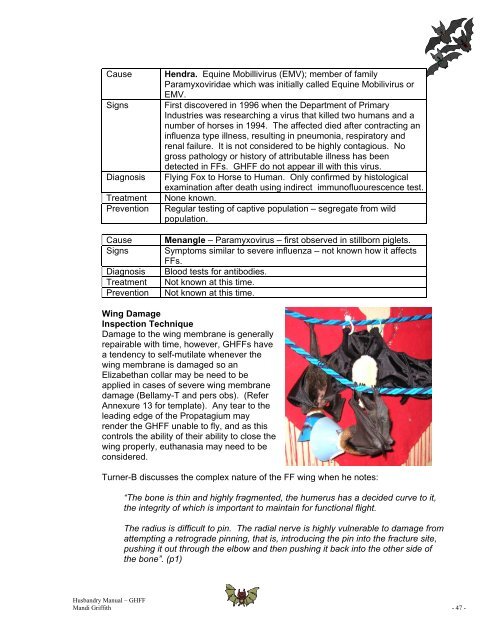Husbandry Manual for Grey- Headed Flying Fox - Nswfmpa.org
Husbandry Manual for Grey- Headed Flying Fox - Nswfmpa.org
Husbandry Manual for Grey- Headed Flying Fox - Nswfmpa.org
Create successful ePaper yourself
Turn your PDF publications into a flip-book with our unique Google optimized e-Paper software.
Cause Hendra. Equine Mobillivirus (EMV); member of family<br />
Paramyxoviridae which was initially called Equine Mobilivirus or<br />
EMV.<br />
Signs First discovered in 1996 when the Department of Primary<br />
Industries was researching a virus that killed two humans and a<br />
number of horses in 1994. The affected died after contracting an<br />
influenza type illness, resulting in pneumonia, respiratory and<br />
renal failure. It is not considered to be highly contagious. No<br />
gross pathology or history of attributable illness has been<br />
detected in FFs. GHFF do not appear ill with this virus.<br />
Diagnosis <strong>Flying</strong> <strong>Fox</strong> to Horse to Human. Only confirmed by histological<br />
examination after death using indirect immunofluourescence test.<br />
Treatment None known.<br />
Prevention Regular testing of captive population – segregate from wild<br />
population.<br />
Cause Menangle – Paramyxovirus – first observed in stillborn piglets.<br />
Signs Symptoms similar to severe influenza – not known how it affects<br />
FFs.<br />
Diagnosis Blood tests <strong>for</strong> antibodies.<br />
Treatment Not known at this time.<br />
Prevention Not known at this time.<br />
Wing Damage<br />
Inspection Technique<br />
Damage to the wing membrane is generally<br />
repairable with time, however, GHFFs have<br />
a tendency to self-mutilate whenever the<br />
wing membrane is damaged so an<br />
Elizabethan collar may be need to be<br />
applied in cases of severe wing membrane<br />
damage (Bellamy-T and pers obs). (Refer<br />
Annexure 13 <strong>for</strong> template). Any tear to the<br />
leading edge of the Propatagium may<br />
render the GHFF unable to fly, and as this<br />
controls the ability of their ability to close the<br />
wing properly, euthanasia may need to be<br />
considered.<br />
Turner-B discusses the complex nature of the FF wing when he notes:<br />
“The bone is thin and highly fragmented, the humerus has a decided curve to it,<br />
the integrity of which is important to maintain <strong>for</strong> functional flight.<br />
The radius is difficult to pin. The radial nerve is highly vulnerable to damage from<br />
attempting a retrograde pinning, that is, introducing the pin into the fracture site,<br />
pushing it out through the elbow and then pushing it back into the other side of<br />
the bone”. (p1)<br />
<strong>Husbandry</strong> <strong>Manual</strong> – GHFF<br />
Mandi Griffith - 47 -

















